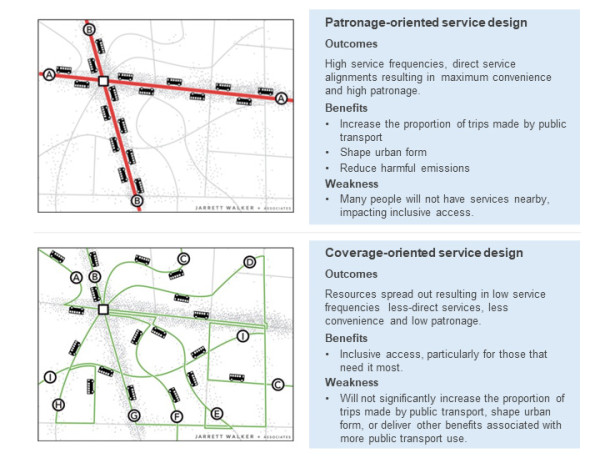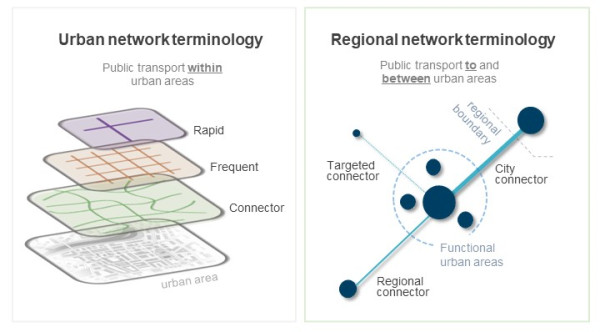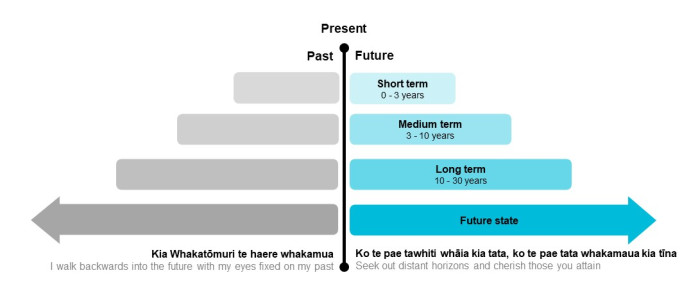There are a number of strategic frameworks that inform the direction and decision-making for public transport in New Zealand and explain public transport’s role in the broader transport system. The national strategic frameworks that shape public transport and the wider transport system are:
This module is organised around the following concepts:
Collectively these elements define context for public transport from the perspective of NZTA. We intend to jointly evolve this collateral with our sector partners over time.
Public transport is defined as the provision of infrastructure and services that enable people to travel within, to, and between urban areas via shared vehicles. The term ‘public transport’ has historically been associated with trains, buses, and ferries that take people from one place to another on fixed routes, at regular times or frequencies. These modes of public transport can be complemented by other forms of shared transport such as cable cars or on-demand services in smaller vehicles.
Public transport supports efficient movement of people and can generate many benefits, depending on where it operates, and the services provided. These benefits are outlined below, reflecting the outcomes described in the Transport Outcomes Framework and the GPS:
Clearly defining New Zealand’s urban areas is foundational to understanding urban and regional terminology, providing the tools for setting strategic direction in a manner that responds to the unique characteristics and challenges of specific geographical areas.
| Urban areas | Major | Large | Medium | Small | Rural settlements | Hinterland |
| Definition pop. size) | 100,000+ | 30,000 to 99,999 | 10,000 to 30,000 | 1,000 to 9,999 | 200 to 999 | Rural |
| Number in NZ | 7 major urban areas | 13 large urban areas | 23 medium urban areas | 152 small urban areas | 402 rural settlements | n/a |
| Combined population | 2,800,000 | 760,000 | 450,000 | 560,000 | 170,000 | 480,000 |
| % of total population |
54% | 15% | 9% | 11% | 3% | 9% |
There are 195 urban areas and 402 rural settlements in New Zealand, based on 2018 Census data and 2021 population estimates. These figures are likely to change over time as New Zealand’s population and distribution changes.
Statistics New Zealand has developed an interactive map, enabling users to determine the urban or rural classification of New Zealand’s towns, cities and settlements.
Urban Rural 2023 (generalised), Statistics New Zealand(external link)
Public transport services should be designed in a manner that responds to context and community need.
At a high-level, there are two service design approaches:
Patronage and coverage-oriented services are neither better nor worse than each other. Rather they result in different outcomes that both are in the public interest.
The role and benefits of public transport varies by context. For example: smaller urban areas may only need coverage-oriented services, whereas larger urban areas may need both patronage and coverage-oriented services to obtain desired benefits. In the short-term, one approach may need to be prioritised over the other as resources are limited.

View a larger version [PDF, 134 KB]
For additional detail relating to service design approaches visit the Human Transit website.
Embedding nationally consistent language for describing public transport networks and services encourages better integration across delivery partners and serves as a crucial foundation of public transport planning practice.
Descriptors for service types are organised according to regional and urban network layers, which each serve a distinct function in connecting people with opportunities. To be practical and relevant across all spatial settings, service descriptors are grounded in function in the first instance, with high-level service characteristics a secondary consideration.
The functional descriptors are currently in draft, pending sector feedback via the proposed Development guidelines for regional public transport plans.

View a detailed overview of the functional descriptors [PDF, 204 KB]
For definition of functional urban areas visit Statistics New Zealand.
Definition of functional urban areas, Statistics NZ(external link)
Defining time horizons allows long-term outcomes to be linked with immediate priorities and actions. It can also address certainty, which is at its highest in the short term and lowest when planning over longer timeframes.
Underpinning a time horizon approach is a set of whakatauki, drawn from te ao Māori. Whakatauki are short sayings that convey wisdom and meaning.
Kia Whakatōmuri te haere whakamua - I walk backwards into the future with my eyes fixed on my past.
This whakatauki tells us that the past is not left behind, instead it continues, shapes the now, and is carried into the future. It reminds us about the holistic nature of a Māori world view and the intrinsic relationship between cultural, economic, environmental and social wellbeing and how these are linked through time.
Ko te pae tawhiti whāia kia tata, ko te pae tata whakamaua kia tīna - Seek out distant horizons and cherish those you attain.
This whakatauki encourages us to do things now that align with our long-term goals, and to appreciate our achievements. It acknowledges that we sometimes fall short, while inspiring us to challenge ourselves and to never stop learning and growing.
Both whakatauki allude to the need to recognise and respect the context in which the public transport system operates and the strong influence of existing urban form and infrastructure which is a legacy of many past decisions and actions. In turn, the decisions and actions that we make now will shape what is possible in the future.

View a larger version [PDF, 43 KB]
There are four time horizons which are defined below:
This time horizon provides a long-term perspective on how public transport services and infrastructure should evolve to obtain desired outcomes. It is informed by major challenges, such as demographic change, technology and data, funding and financing challenges, changing travel patterns, changing economic structure and climate change. These drivers can create planning uncertainty. Articulating a future state defines the direction of travel, not the exact destination. This time horizon precedes other shorter-term planning and funding processes that determine if, when, and how a future state can be realised.
The long-term planning horizon is the domain of integrated land use and transport planning. There are several tools we can use to help us plan for the future, such as district plans, spatial plans and future development strategies. Arataki, our 30-year plan, looks to the long-term to outline a future focus for New Zealand’s land transport system and the modes that comprise it. The long-term time horizon allows us to be clear about major infrastructure needs, capital investments and institutional changes required to give effect to integrated plans and strategies. As in the future state, long-term planning can be highly uncertain as the extended period can see significant changes in the economy, technology, society and environment.
Medium-term planning is the domain of the Government Policy Statement on Land Transport (GPS), Regional Land Transport Plans (RLTPs) and Regional Public Transport Plans (RPTPs). These are all statutory documents prepared under the Land Transport Management Act:
Medium-term planning allows for the organisation of transport activities into feasible and fundable programmes and projects. Medium-term planning addresses immediate priorities while also giving effect to longer term land use plans and transport strategies. This time horizon provides more planning certainty, but the potential for changes in policy shifts, economic conditions and technology advancements is still possible.
This time horizon is all about planning, optimisation, implementation and delivery of already funded transport activities.
The following diagram outlines the NZTA’s view of the relevant functions of public transport and the benefits sought by spatial context at a high-level. It signals a longer-term direction that precedes other shorter-term planning and funding processes that determine if, when, and how a future state can be realised.
Population and spatial context are among many factors that influence the outcomes sought from public transport. This diagram is indicative only. Outcomes and service types should be assessed on a case by case basis and can change over time as context changes. We expect to evolve this diagram in collaboration with our sector partners.
Future state of public transport [PDF, 77 KB]
Currently the functional descriptors are draft, pending sector feedback via the proposed Development guidelines for regional public transport plans.
The New Zealand Transport Agency’s public transport priorities have a short to medium focus. They reflect and are consistent with the outcomes described in the future state, the longer-term direction set out in Arataki and the Transport Outcomes Framework, and the priorities set by the GPS.
Deliver on current GPS priorities
We will work with our partners to deliver an efficient and effective public transport system that enables value for money by:
We will focus on reducing travel time, congestion and emissions by supporting delivery of major public transport projects signalled in the GPS.
Enabling capacity for growth in the right place at the right time
We will work with our partners to plan and deliver reliable, effective, and efficient networks and systems that lay the foundations for growth of the public transport system and the number of people who use
Shaping urban form and growing productivity
We will leverage investment in rapid transit and frequent networks to make more efficient use of existing infrastructure and enable productive and integrated urban environments.
Enhancing inclusive access
We will plan for and enable safe and inclusive access, particularly for those who need it most, by developing and improving targeted and cost-effective solutions. This includes different forms of demand responsive services such as on-demand public transport, Total Mobility and community transport initiatives.
Improving the use of technology
We will leverage the use of a national ticketing solution and other innovative technology systems to enhance sector productivity and better meet the needs of customers.